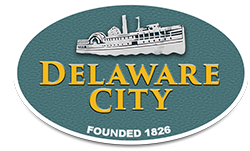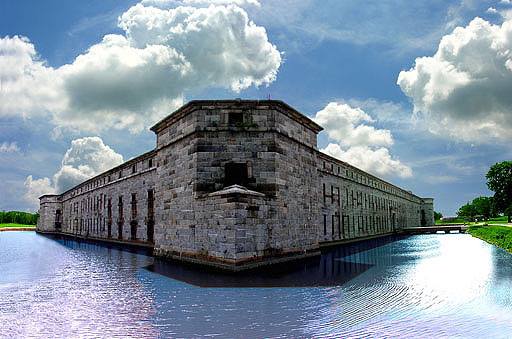Due to the importance of this little town in the development of commerce in the country, much has been restored here iviting guests to come, learn and experience. The American Guide Series, published in 1938 described the town before the history became its saving factor. However, it does tell a lot of history…
“DELAWARE CITY, 9.7 m. (10 alt., 1,005 pop.), is a river town of broad, tree-shaded streets, old brick hotels that have been closed as such for decades, and one of the most charming waterfronts in Delaware. On lower Clinton St. the row of stores of varying heights, built in a solid line, has not changed appreciably in 40 years. A few small boats of shallow draft lie at the wharf on the former basin of what was once the main entrance to the Chesapeake and Delaware Canal. The Steamboat Wharf no longer resounds with the thump of peach baskets or the laughter of rich farmers boarding the Major Reybold or the Thomas Clyde for Philadelphia. No more passenger trains come in on the branch rail line, and the trolley tracks have been torn up ; some of the residents commute to Wilmington by bus or automobile. Old shad and sturgeon skiffs blister in the sun on the old towpath, nets rot away in dark barn lofts. Soldiers from Fort Du Pont stroll with their town girls in grassy Battery Park where the whole community used to gather at evenings to see the Lord Baltimore or the William Penn enter the locks on the way from Philadelphia to Baltimore. Hip-booted fishermen, gunners, or trappers according to the season clump slowly about.
Delaware City superficially resembles other Delaware tidewater villages that flourished for 40 or 50 years on shipbuilding and the transportation of grain and forest products, and then were withered by the railroad. But these places sleep peacefully, undisturbed by ambition. Delaware City is different. There is always, going on in the vicinity, or planned for the future, some large undertaking that may restore prosperity.
For 25 years a river wharf here had been called Newbold’s Landing. But when the fine wide streets were laid out in 1826 at the junction of the Delaware River and the Chesapeake and Delaware Canal then being dug across the Peninsula, Daniel and William Newbold, who drew the plans, gave the proposed town the grandiose name of Delaware City in expectation of future glory; the main street was named for Governor De Witt Clinton of New York, chief promoter of the Erie Canal, and a lot of less than an acre sold for $4,000.
Then this first boom subsided and the Newbolds sold out to Manuel Eyre, another promoter; on July 4, 1827 a great dinner was held in the street at a table a block long; companies of militia paraded and important men spoke. The next year a brick hotel and other buildings were erected on Clinton St., and an optimistic little town greeted in 1829 the opening of the canal. Lock tenders and toll-receivers were soon busy locking through the barges of lumber, coal, lime, and grain. Large stables arose on the canal bank for the mules that plodded along the towpath pulling boats. But the canal brought no great development because the railroads soon began to compete seriously.” – Delaware: A Guide to the First State
Delaware City began as Newbold’s Landing in 1801, with the intentions of becoming an important river port. Due to its location at the entrance to the Chesapeake and Delaware Canal, trade boomed. During the 1800s, Delaware City caused a peach boom, popularizing peaches nationwide. The canal was essential for the quick movement of these fragile produces.
Soldiers were still stationed at both Fort Delaware and Fort DuPont, providing needed visitors to the town. Fort Delaware closed in 1944, and Fort Dupont not long after.
Advances in shipping vessels caused the locks along this canal to become too small, too shallow, too inadequate. The railroad became an easier mode of transportation, and Delaware City went through yet another decline in it’s commerce.
After Fort Delaware closed, a local historical society began renovating the structure and it is now an impressive state park. The ferry to Pea Patch Island where the fort stands leaves from Delaware City’s Battery Park (and from Fort Mott on the Jersey side). Fort Delaware played an important role in the American Civil War.
Today, thanks to the historical restoration of this pivotal town, visitors can once again walk the battery park by the canal, visit the shops and restaurants and be a part of American History.


